Unraveling The Secrets Behind Pope’s Mitre Shaped Like A Fish And The Dogon Connection
Gregg Prescott, M.S. – MessageToEagle.com – Did you ever wonder why the Pope’s mitre looks like the head of a fish?
What are the origins of this ceremonial hat and what does it truly represent?
What is the origin of the Pope’s hat?
Dagon, the fish-god of the Philistines and Babylonians, wore a fish hat that is still seen today with Roman Catholic Church’s pope and bishops.
According to Ruben Joseph’s book entitled, Why Are The Young People Leaving The Church, “The miter is derived directly from the miters of the ancient pagan fish-god dagon and the goddess Cybele.
The papal miter represents the head of Dagon with an open mouth, which is the reason for the pointed shape and split top.”
The story the church wants you to believe is provided by a PDF entitled, “The Bishop’s Vestments” while an online version of this explanation can be found here.
“The shape of the mitre represents the tongues of fire that rested on the heads of the disciples gathered in the upper room on the Day of Pentecost, when God sent the Holy Spirit to the Church.”
Probably not, it’s a fish eye.
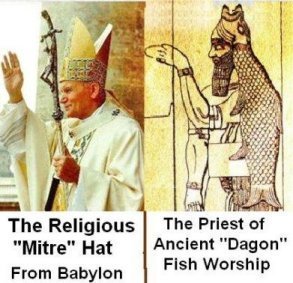
The book Nineveh and Babylon by Austen Henry Layard stated:
“In their veneration and worship of Dagon, the high priest of paganism would actually put on a garment that had been created from a huge fish! The head of the fish formed a mitre above that of the old man, while its scaly, fan-like tail fell as a cloak behind, leaving the human limbs and feet exposed.”
The Wine of Babylon stated:

The most prominent form of worship in Babylon was dedicated to Dagon, later known as Ichthys, or the fish. In Chaldean times, the head of the church was the representative of Dagon, he was considered to be infallible, and was addressed as ‘Your Holiness’.
Nations subdued by Babylon had to kiss the ring and slipper of the Babylonian god-king. The same powers and the same titles are claimed to this day by the Dalai Lama of Buddhism, and the Pope. Moreover, the vestments of paganism, the fish mitre and robes of the priests of Dagon are worn by the Catholic bishops, cardinals and popes.
Ea Enki, who is a God of Sumerian (Enki) and Babylonian (Ea) mythology.
In Babylonian mythology, Ea was a water god who was half man, half fish hybrid. In Greek mythology, Ea was known as Oannes. By any name, this fish-god can be traced back to the genetic manipulation of man by Anunnaki, as evidenced by Zecharia Sitchen’s work.
It is believed that, in the daytime, this deity would emerge from the water and was responsible for teaching art, science and writing to the human race.
Berossus, a 3rd century Babylonian priest once wrote:
“At first they led a somewhat wretched existence and lived without rule after the manner of beasts. But, in the first year after the flood appeared an animal endowed with human reason, named Oannes, who rose from out of the Erythian Sea, at the point where it borders Babylonia.
He had the whole body of a fish, but above his fish’s head he had another head which was that of a man, and human feet emerged from beneath his fish’s tail. He had a human voice, and an image of him is preserved unto this day. He passed the day in the midst of men without taking food; he taught them the use of letters, sciences and arts of all kinds.
He taught them to construct cities, to found temples, to compile laws, and explained to them the principles of geometrical knowledge. He made them distinguish the seeds of the earth, and showed them how to collect the fruits; in short he instructed them in everything which could tend to soften human manners and humanize their laws. From that time nothing material has been added by way of improvement to his instructions. And when the sun set, this being Oannes, retired again into the sea, for he was amphibious.”
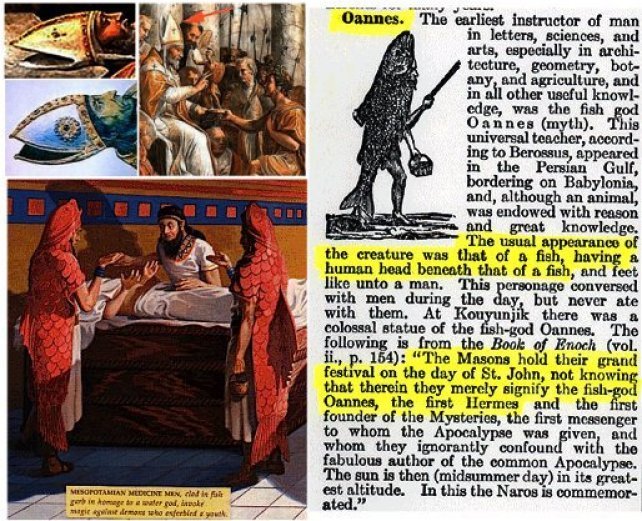
“The chief priests wore miters shaped like the head of fish, in honor of Dagon, the fish-god, the lord of life – another form of the Tammuz mystery, as developed among Israel’s old enemies, the Philistines. When the chief priest was established in Rome, he took the title Pontifex Maximus, which was imprinted on his miter.
When Julius Caesar (who like all young Roman of good family, was an initiate) had become the head of State, he was elected Pontifex Maximus, and this title was held henceforth by all of the Roman emperors down to Constantine the Great, who was, at one and the same time, head of the church and high priest of the heathen!
The title was afterward conferred upon the bishops of Rome and is today borne by the pope, who is thus declared to be, not the successor of the fisherman-apostle Peter, but the direct successor of the high priest of the Babylonian mysteries and the servant of the fish-god Dagon, for whom he wears, like his idolatrous predecessor, the fisherman’s ring.”
Did you ever wonder why people kiss the Pope’s ring?
Why do so many people of prominence kiss the Pope’s ring?
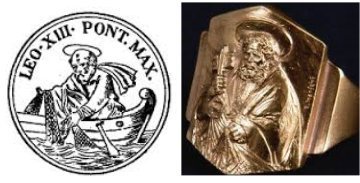
The Ring of the Fisherman, also known as the Piscatory Ring, is an official part of the regalia worn by the Pope, who is head of the Catholic Church and successor of Saint Peter, who was a fisherman by trade. It used to feature a bas-relief of Peter fishing from a boat, a symbolism derived from the tradition that the apostles were “fishers of men” (Mark 1:17).
The Fisherman’s Ring is a signet used until 1842 to seal official documents signed by the Pope.
In breaking with this tradition:
“At the official introduction to his office, the classic ring remained in its case. It was passed to Pope Benedict XVI by the dean of the College of Cardinals, Angelo Cardinal Sodano. The ring was designed by jeweller Claudio Franchi, who watched as Benedict placed the ring on himself.” Although Pope Benedict XVI wore his Fisherman’s Ring daily, it is no longer the custom for popes to wear it at all. Generally, a new pope will either inherit the daily-wear ring of his predecessor, keep an old ring of his own preference, or will choose a new daily-wear style.
Why is it no longer custom for the pope to wear this ring? Because in astrotheology, we are existing out of the Age of Pisces (the two fish) and into the Age of Aquarius. The ring no longer symbolizes the Age of Pisces. Instead of seeing the two fish on people’s bumper stickers, we will soon start seeing some sort of sign for the water bearer, Aquarius.
Who is Dagon?
In the bible, Dagon dates back to around the 3rd millennium, B.C., long before the birth of Jesus Christ and was first mentioned in Judges 16:23, where the Philistines offered Dagon a great sacrifice after their idol allegedly delivered Samson to them.
Then the lords of the Philistines gathered them together for to offer a great sacrifice unto Dagon their god, and to rejoice: for they said, Our god hath delivered Samson our enemy into our hand.
Judges 16:23
This is just one of the many ritualistic sacrifices that we see in the bible and is no different than any modern day sacrifice, such as 9/11 or any given war.
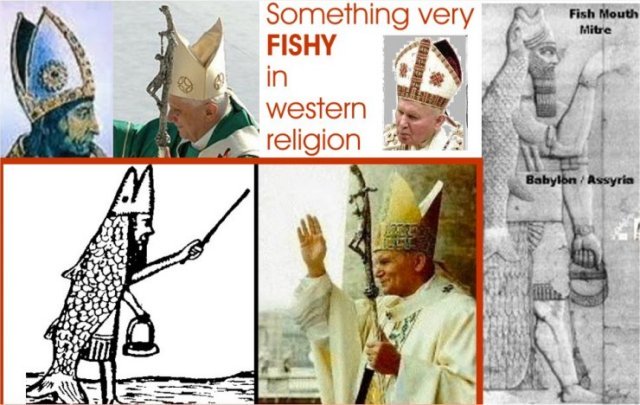
Many consider the Canaanites to be part of the Philistines who worshipped worshiped Baal, Astarte and Dagon. These were some of the early sun-worshipping cultures that have led to many of the metaphors we see in modern religion, e.g. God’s son/sun.
In Mali, there is a tribe called the Dogons, whose legends from their heritage were used by the Egyptians and subsequent dynasties. The Dogon knew of constellations and alignments that we didn’t ‘discover’ until many years later, such as Sirius B.
According to Dogon legend, the Nommos arrived from the Sirius star system in a vessel along with fire and thunder, or as we would say today, in a UFO. The Nommos were part fish and part man and could live on both land and in the sea. They are also referred to as “Masters of the Water”, “the Monitors”, and “the Teachers”.
Perhaps frogs, dolphins and whales were placed here by the Nommos? Even the mystery of mermaids may originate from this premise.
Throughout mythology, we see fish-like people, mermaids and mermen, such as Poseidon or Neptune. An excerpt from Ancient Pagan and Modern Christian Symbolism stated:
According to Egyptian mythology, when the judges found Osiris [Nimrod] guilty of corrupting the religion of Adam and cut up his body, they threw the parts into the Nile. It was said that a fish ate one of these chunks and became transformed. Later, Isis [Semiramis] was fishing along the river bank when she fished up a half-man, half-fish. This sea creature was Dagon, the reincarnated Nimrod. And Dagon is the representation of Nimrod (of ancient Babylon) resurrecting out of the ocean depths as a half-man, half-fish.
Why do we eat fish on Friday?
Why do we see fish frys on Friday? Did you ever wonder why practicing Catholics abstain from eating fish on all days except Friday?
It is not because of the phonetics of Fry-Day. The origin of Friday come s from Freya’s Day. Freya (Fria) is the Teutonic goddess of love, beauty, and fecundity (prolific procreation) and is identified with the Norse god, Freya.
The following is provided by the History of Origin of Fish Symbol:
“In Greece the Greek word “delphos” meant both fish and womb. The word is derived from the location of the ancient Oracle at Delphi who worshipped the original fish goddess, Themis. The later fish Goddess, Aphrodite Salacia, was worshipped by her followers on her sacred day, Friday. They ate fish and engaging in orgies. From her name comes the English word “salacious” which means lustful or obscene. Also from her name comes the name of our fourth month, April. In later centuries, the Christian church adsorbed this tradition by requiring the faithful to eat fish on Friday – a tradition that was only recently abandoned.
According to The Catholic Encyclopedia: An International Work of Reference on the Constitution, Doctrine, Discipline, and History of the Catholic Church: As to the ritual of his worship… we only know from ancient writers that, for religious reasons, most of the Syrian peoples abstained from eating fish, a practice that one is naturally inclined to connect with the worship of a fish-god.
More fish food for thought
In the Revelation chapter of the Bible it states the beast shall rise out of the sea: “And I stood upon the sand of the sea, and saw a beast rise up out of the sea, having seven heads and ten horns, and upon his horns ten crowns, and upon his heads the name of blasphemy. – Revelation 13:1
Perhaps this is responsible for the term “Holy See” (Holy Sea)?
It is certainly no coincidence that the entire planet abides by Maritime Admiralty Law, which is the law of the sea (Holy See).
As for the pope’s miter, it’s a fish hat and its origin is tied into mythology, ufology, paganism and sun worshipping.
Written by Gregg Prescott, M.S. – MessageToEagle.com Contributor
Related Posts
-
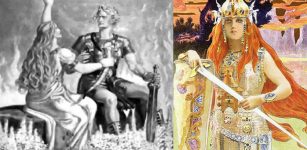 Valkyries Sigrdriva And Brynhildr: Brave Warriors Who Were Punished By God Odin In Norse And Germanic Mythology
No Comments | Apr 4, 2017
Valkyries Sigrdriva And Brynhildr: Brave Warriors Who Were Punished By God Odin In Norse And Germanic Mythology
No Comments | Apr 4, 2017 -
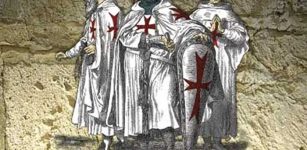 Book Review: The Knights Templar And Other Secret Societies Of The Middle Ages By Thomas Keightley
No Comments | Jan 14, 2017
Book Review: The Knights Templar And Other Secret Societies Of The Middle Ages By Thomas Keightley
No Comments | Jan 14, 2017 -
 3,400-Year-Old Cuneiform Tablet Excavated In Old City Of Alalah
No Comments | Aug 22, 2020
3,400-Year-Old Cuneiform Tablet Excavated In Old City Of Alalah
No Comments | Aug 22, 2020 -
 Ancient Suda: Massive Anonymous Byzantine-Greek Lexicon Dated To 10th Century
No Comments | Apr 25, 2016
Ancient Suda: Massive Anonymous Byzantine-Greek Lexicon Dated To 10th Century
No Comments | Apr 25, 2016 -
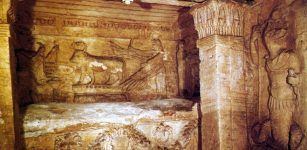 Underground Catacombs Of Alexandria: Ancient Time Capsule Which Remained Hidden For Almost Two Millennia
No Comments | Sep 20, 2016
Underground Catacombs Of Alexandria: Ancient Time Capsule Which Remained Hidden For Almost Two Millennia
No Comments | Sep 20, 2016 -
 Stamp Suggests The Iconic Sutton Hoo Helmet Was Made In Denmark, Potentially Rewriting Early European History
No Comments | Apr 2, 2025
Stamp Suggests The Iconic Sutton Hoo Helmet Was Made In Denmark, Potentially Rewriting Early European History
No Comments | Apr 2, 2025 -
 Existence Of Man Before Adam Re-Writes History
No Comments | Sep 1, 2015
Existence Of Man Before Adam Re-Writes History
No Comments | Sep 1, 2015 -
 Surprising Discovery Of Box Filled With Neanderthal Bones From Cova Simanya Donated To Museum
No Comments | Sep 24, 2023
Surprising Discovery Of Box Filled With Neanderthal Bones From Cova Simanya Donated To Museum
No Comments | Sep 24, 2023 -
 How Gilgamesh Defeated Mighty King Agga Of Kish
No Comments | Nov 16, 2016
How Gilgamesh Defeated Mighty King Agga Of Kish
No Comments | Nov 16, 2016 -
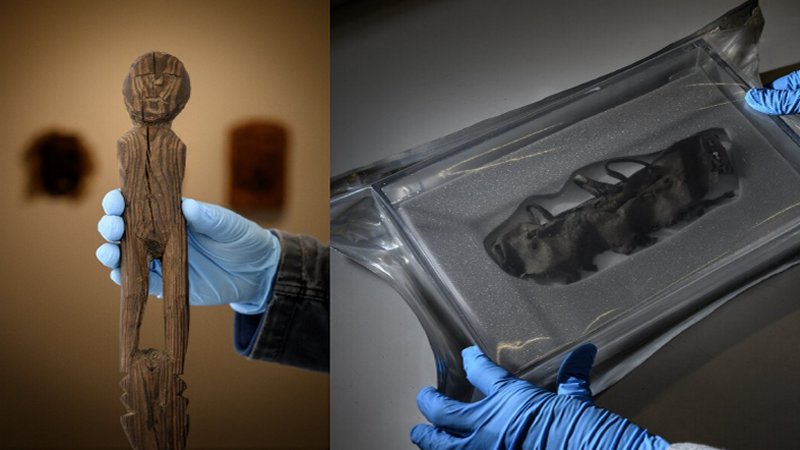 Ancient Artifacts Hidden Beneath The Ice In Danger As Glaciers Are Melting
No Comments | Oct 19, 2020
Ancient Artifacts Hidden Beneath The Ice In Danger As Glaciers Are Melting
No Comments | Oct 19, 2020
